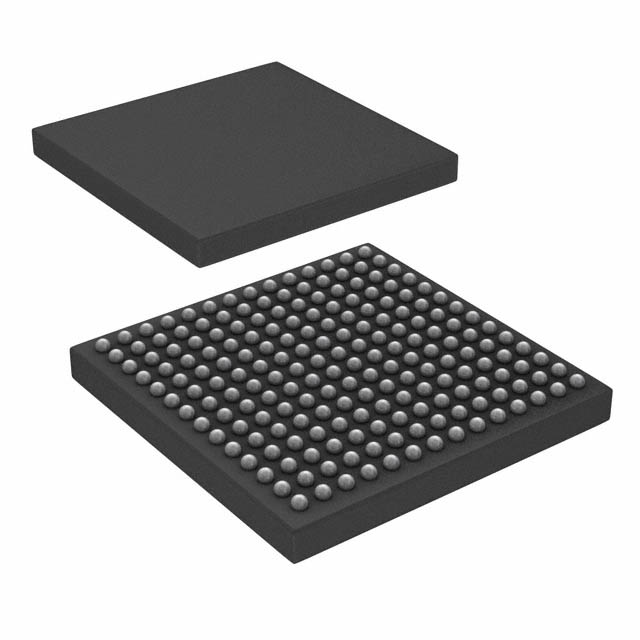ADSP-21992YBC
Product Overview
Category
ADSP-21992YBC belongs to the category of digital signal processors (DSPs).
Use
This product is primarily used for processing and manipulating digital signals in various applications such as audio and video processing, telecommunications, control systems, and image processing.
Characteristics
- High-performance DSP with advanced signal processing capabilities
- Low power consumption
- Compact size
- Integrated peripherals for enhanced functionality
Package
ADSP-21992YBC is available in a compact package that ensures easy integration into electronic devices. The package includes the necessary pins for connectivity and mounting.
Essence
The essence of ADSP-21992YBC lies in its ability to efficiently process digital signals, enabling complex algorithms and computations in real-time applications.
Packaging/Quantity
ADSP-21992YBC is typically packaged individually and is available in varying quantities depending on the manufacturer's specifications.
Specifications
- Architecture: Harvard architecture
- Clock Speed: Up to 200 MHz
- Instruction Set: Modified Harvard architecture instruction set
- Data Memory: Up to 256 KB
- Program Memory: Up to 512 KB
- Digital I/O Pins: Multiple configurable I/O pins
- Analog Inputs: Multiple analog input channels
- Power Supply: 3.3V
Detailed Pin Configuration
The pin configuration of ADSP-21992YBC is as follows:
- VDD - Power supply voltage
- GND - Ground
- RESET - Reset pin
- CLKIN - External clock input
- CLKOUT - Clock output
- A0-A15 - Address bus
- D0-D15 - Data bus
- INT - Interrupt pin
- RD - Read control pin
- WR - Write control pin
- CS - Chip select pin
- ALE - Address latch enable
- RDY - Ready pin
Functional Features
- High-speed signal processing capabilities
- Multiple integrated peripherals for enhanced functionality
- Efficient power management features
- Support for various communication protocols
- Flexible memory options for data storage and program execution
Advantages and Disadvantages
Advantages
- High-performance signal processing capabilities
- Low power consumption
- Compact size for easy integration
- Versatile peripheral support
- Flexible memory options
Disadvantages
- Limited availability of alternative models
- Steep learning curve for programming and optimization
Working Principles
ADSP-21992YBC operates on the principles of digital signal processing, utilizing its high-speed architecture and specialized instructions to perform complex computations on digital signals. It follows a Harvard architecture, allowing simultaneous access to program and data memories.
The processor fetches instructions from the program memory, performs calculations on the data using its arithmetic logic unit (ALU), and stores the results back in memory or outputs them through the I/O pins.
Detailed Application Field Plans
ADSP-21992YBC finds applications in various fields, including:
- Audio and Video Processing: Used in audio and video equipment for real-time signal processing, such as noise reduction, equalization, and compression.
- Telecommunications: Employed in telecommunication systems for tasks like voice coding, echo cancellation, and channel equalization.
- Control Systems: Utilized in control systems for feedback control, motor control, and sensor signal processing.
- Image Processing: Applied in image processing applications for tasks like image enhancement, object recognition, and pattern matching.
Detailed and Complete Alternative Models
While ADSP-21992YBC is a highly capable DSP, there are alternative models available in the market that offer similar functionalities. Some notable alternatives include:
- TMS320C6748: A DSP from Texas Instruments with comparable performance and features.
- STM32F4xx: A series of microcontrollers from STMicroelectronics that offer DSP capabilities along with general-purpose computing.
These alternative models provide options for developers based on their specific requirements and preferences.
In conclusion, ADSP-21992YBC is a powerful digital signal processor with advanced signal processing capabilities. Its compact size, low power consumption, and integrated peripherals make it suitable for various applications. While it has advantages such as high performance and versatile functionality, it also has limitations in terms of availability of alternative models and programming complexity. Nonetheless, its working principles and detailed application field plans demonstrate its potential in audio and video processing, telecommunications, control systems, and image processing.
技術ソリューションにおける ADSP-21992YBC の適用に関連する 10 件の一般的な質問と回答をリストします。
Sure! Here are 10 common questions and answers related to the application of ADSP-21992YBC in technical solutions:
Q: What is ADSP-21992YBC? A: ADSP-21992YBC is a digital signal processor (DSP) developed by Analog Devices Inc., designed for high-performance audio and industrial applications.
Q: What are the key features of ADSP-21992YBC? A: Some key features include a 32-bit fixed-point DSP core, multiple integrated peripherals, on-chip memory, and support for various communication interfaces.
Q: What are the typical applications of ADSP-21992YBC? A: ADSP-21992YBC is commonly used in audio processing systems, motor control, industrial automation, telecommunications, and other real-time signal processing applications.
Q: How much on-chip memory does ADSP-21992YBC have? A: ADSP-21992YBC has 256KB of on-chip program memory (ROM) and 40KB of on-chip data memory (RAM).
Q: Can ADSP-21992YBC be used for real-time audio processing? A: Yes, ADSP-21992YBC is well-suited for real-time audio processing due to its high-performance DSP core and integrated peripherals.
Q: Does ADSP-21992YBC support external memory expansion? A: Yes, ADSP-21992YBC supports external memory expansion through its external memory interface (EMIF), allowing for additional program and data storage.
Q: What communication interfaces are supported by ADSP-21992YBC? A: ADSP-21992YBC supports various communication interfaces such as SPI, I2C, UART, and SPORT (Serial Port).
Q: Can ADSP-21992YBC be programmed using C/C++? A: Yes, ADSP-21992YBC can be programmed using C/C++ along with Analog Devices' VisualDSP++ development environment.
Q: Is ADSP-21992YBC suitable for low-power applications? A: Yes, ADSP-21992YBC is designed to be power-efficient and offers various power-saving features, making it suitable for low-power applications.
Q: Are evaluation boards available for ADSP-21992YBC? A: Yes, Analog Devices provides evaluation boards and development kits specifically designed for ADSP-21992YBC, which help in the prototyping and development of technical solutions.
Please note that these answers are general and may vary depending on specific requirements and use cases.


